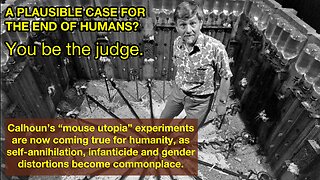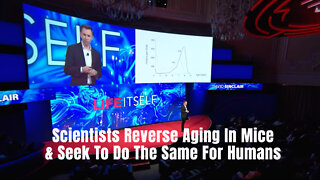How The Woman Got Her Period - Evolutionary Biology
The Story of Why & How Menstruation is so important and unique to Women & Girls!
Links / References
Suzanne Sadedin & Jennifer Thetford-Kay:
The evolution of menstruation: A new model for genetic assimilation
Genetic conflicts in human pregnancy.
Menstruation: a nonadaptive consequence of uterin... [Q Rev Biol. 1998]
Natural Selection of Human Embryos: Decidualizing Endometrial Stromal Cells Serve as Sensors of Embryo Quality upon Implantation
The role of invasive trophoblast in implantation and placentation of primates
References for the mouse implantation studies:
Runner, M. N. (1947) Development of mouse eggs in the anterior chamber of the eye. Anatomical Record 98: 1-17.
Kirby, D. R. S. (1965) The "invasiveness" of the trophoblast. Pages 68-73, in W. W. Park (ed.), The early conceptus, normal and abnormal. University of St. Andrews, St. Andrews.
* mouse blastocysts implanted in kidney, spleen, testis, brain, liver
McLaren, A. (1965) Maternal factors in nidation. Pages 27-33, in W. W. Park (ed.), The early conceptus, normal and abnormal. University of St. Andrews, St. Andrews.
"The fact that successful implantation and subsequent development can occur in the testis emphasises the most striking and, to me, unexpected feature of implantation outside the uterus, namely, that it is entirely independent of the sex or hormonal status of the host. Pregnant females, non-pregnant females and males all provided an apparently equally good substrate for implantation in Kirby's experiments …"
"What a contrast this makes to the situation inside the uterus! The experiments so far might lead one to think that the rodent blastocyst's capacity to implant and develop was so strong that only the most unfavourable of circumstances could stop it. Yet the uterus, which one might picture as especially welcoming and receptive, is in fact so inimical to implantation that there is only a brief period of time during which a blastocyst placed within it can hope to survive."
Credits: During my pregnancy I was privileged to audit a class at Harvard University by the eminent Professor David Haig, whose insight underlies much of this research. Thanks also to Edgar A. Duenez-Guzman, who reminded me of crucial details. All errors are mine alone.
*Dogs undergo vaginal bleeding, but do not menstruate. Elephant shrews were previously thought to menstruate, but it's now believed that these events were most likely spontaneous abortions.
** Scientists Discover Children’s Cells Living in Mothers’ Brains (Thanks to User-12417258381097220018 for the link).
***One older published estimate for hunter gatherers was around 50, but this relied on several assumptions, including 3 whole years of menstruation before reproduction (36 periods) for no obvious reason.
A study of the Dogon of Mali based on 57 women in natural-fertility cycles estimates the median number of life-time menses at 109: http://www.jstor.org/stable/2744446
To get a feel for life history parameters, we can look at data from the Hadza of Tanzania, who reach puberty around 18, bear an average of 6.2 children in their lives (plus 2-3 noticeable miscarriages) starting at 19, and go through menopause at about 43 if they survive that long (about 50% don't). Around 20% of babies die in their first year; the remainder breastfeed for about 4 years. So this is 25 years of reproductive life, of which about 20 are spent lactating, and 4.5 pregnant. That would leave only about 6 periods, but amenorrhoea would cease during the last year of lactation for each child, so this figure is too low. On the other hand, this calculation ignores the ~50% of women who died before menopause, miscarriages, months spent breastfeeding infants who would die, and periods of food scarcity, all of which would further reduce lifetime menstruation. Stats from: http://www.fas.harvard.edu/%7Ehbe-lab/acrobatfiles/who%20tends%20hadza%20children.pdf
https://www.youtube.com/watch?v=vG9o9m0LsbI&t=106s&ab_channel=OldTVTime
Music
SONG Nutcracker suite op.71a Flower Waltz
ARTIST London Festival Orchestra, Alberto Lizzio
ALBUM The Best of TSCHAIKOWSKY
https://youtu.be/QxHkLdQy5f0
––––––––––––––––––––––––––––––
Music: Blue Danube - Strauss
• Blue Danube – Str...
––––––––––––––––––––––––––––––
✅ About using the music:
- You can use it ONLY for YouTube videos.
- Your use of this music is subject to the YouTube Terms of Service (https://www.youtube.com/t/terms)
- The music is intended solely for use by you in videos and other content that you create.
- You may use music files from this library in videos that you monetize on YouTube.
- You will not make available, distribute or perform the music files from YouTube Audio Library separately from videos and other content into which you have incorporated these music files (e.g., standalone distribution of these files is not permitted).
- You will not use music files from YouTube Audio Library in an illegal manner or in connection with any illegal content.
———
-
 7:15
7:15
Dr. Eric Berg
4 years agoWhat is Menopause... Really
331 -
 1:51:09
1:51:09
RAVries
1 year agoA Plausible Case For The End of Humans? You be the judge -- Calhoun’s “mouse utopia” experiments are now coming true for humanity as self-annihilation, infanticide and gender distortions become commonplace
973 -
 1:36:57
1:36:57
Mind & Matter Podcast
2 years agoBlanche Capel: Sex Determination, Sex Hormones & Chromosomes, Development & Evolution of Sex | #68
17 -
 1:13:51
1:13:51
Mikhaila Peterson
2 years agoMen and Women and Evolution | Bret Weinstein & Heather Heying - MP Podcast #114
8.13K13 -
 1:50
1:50
yonatandemlie
1 year agoWoman facts: 15 surprising revelations about the female species
11 -
 1:03:40
1:03:40
The Heavenly Tea
10 months agoTransformational Energy Exchange: MALE / FEMALE
107 -
 0:13
0:13
drpatrickflynn
1 year agoWoman/Sugar #sugar #woman #periods #cycle #shorts #food #body #health #healthy #bhfyp #asmr #stress
72 -
 10:13
10:13
ForeverSwinging89
9 months agoIntroduction | Biological Female on the Necessity of This Content
175 -
 27:19
27:19
Sunfellow On COVID-19
2 years agoScientists Reverse Aging In Mice & Seek To Do The Same For Humans
1.13K8 -
 4:33
4:33
Amazing Psychology Facts
11 months agoBusting the Myth Psychology Facts about Sex and Menopause| human body
29